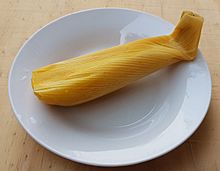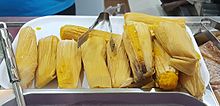Binaki facts for kids
 
Bukidnon binaki
|
|
| Alternative names | Pintos |
|---|---|
| Course | Dessert, Snack |
| Place of origin | Philippines |
| Region or state | Bukidnon, Northern Mindanao; Bogo, Northern Cebu |
| Serving temperature | Warm, room temperature |
| Main ingredients | Cornmeal, coconut milk (or milk), margarine (or butter), sugar, baking powder, |
| Variations | Biyaki |
Binaki (say "bee-NAH-kee") and pintos are yummy sweet treats from the Philippines. They are a type of tamale, which is a dish often made from corn dough and steamed. These special snacks come from two areas: Bukidnon and Bogo, Cebu.
What makes them unique is how they are wrapped. They are usually wrapped in corn husks, which are the leafy coverings of corn on the cob. You can often find binaki and pintos sold as street food. They are also popular as pasalubong, which are gifts or souvenirs people bring home from a trip. Sometimes, people call them "steamed corn cakes" in English.
What are Binaki and Pintos?
Binaki and pintos are sweet versions of Philippine tamales. They don't have any fillings inside. These treats developed separately in Bukidnon and Bogo, Cebu. Both are traditionally wrapped in corn husks.
You can often tell them apart by how they are wrapped. Binaki usually has a longer, narrower wrapping. Pintos is shorter and shaped more like a rectangle. It also has extra ties wrapped around it. The names binaki and pintos both mean "wrapped in a pouch." The name binaki comes from a word meaning "frog-shaped pouch." Pintos comes from a word meaning "wrapped."
How are they Made?
Making binaki and pintos is quite similar. First, young corn ears are scraped using a grater. This makes a coarse corn mixture, like a rough cornmeal. This corn mixture is then blended with other ingredients. These include coconut milk (or regular milk), margarine (or butter), baking powder, and white sugar or brown sugar.
Sometimes, instead of coconut milk and sugar, condensed milk is used. Occasionally, cheese might be added, but this is not very common. Once the mixture is ready, it's scooped into corn husks. Then, these wrapped treats are steamed until they become firm.
Other Types of Corn Cakes
There is a similar dish called biyaki. This variant comes from the Maranao people. It was inspired by the binaki from Bukidnon. However, biyaki is now quite different and is usually seen as its own dish.
Biyaki mainly uses grated cassava, which is a root vegetable. Only small bits of grated young corn kernels are mixed in. Biyaki is often sold wrapped in banana leaves, similar to suman. But it can also be wrapped in corn husks, just like binaki and pintos.

